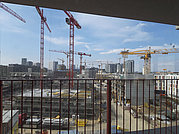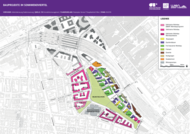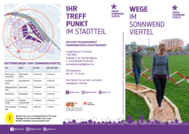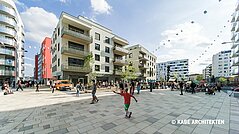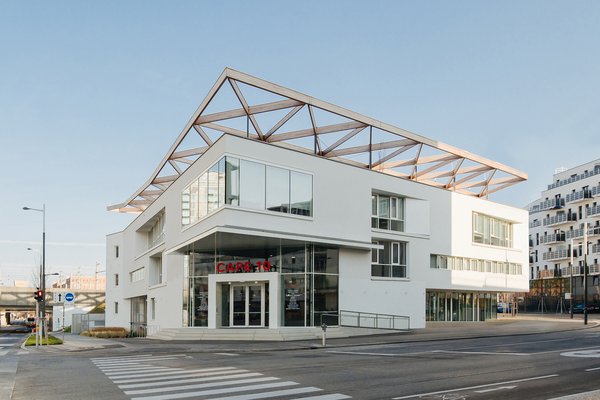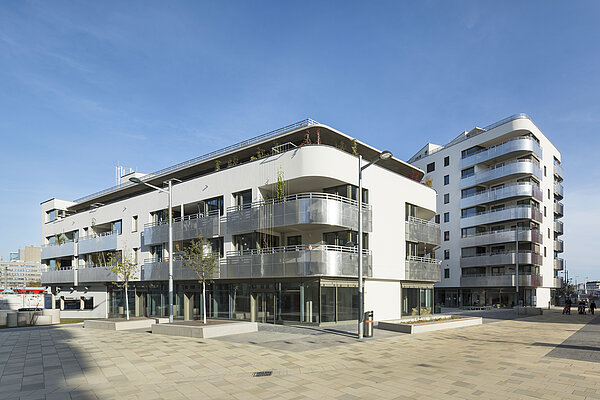To neighborhood walk

Quartiershäuser Sonnwendviertel
1100 Wien
Cooperation Partners
Lienfeldergasse 96
1170 wien
To neighborhood walk

Tips in the Grätzel
The approximately seven-hectare park in the Sonnwendviertel is a popular meeting place and offers a variety of uses.
Community gardening is fun and builds strong neighborhood networks. The garden of approx. 800 m² is located in the second section of the Helmut-Zilk-Park.
For those interested in art and culture, the Sonnwendviertel has a particularly colorful offer. The restaurants and pubs in the district invite visitors, small studios can be discovered and there is always an opportunity to participate in events!
Urban building blocks for the neighborhood
>> The basic idea was that by having a good mix of properties sold without conditions and those that had to meet certain criteria, you could create a livable and urban district overall. <<
Robert Temel, Spokesman of the Building Culture Policy Platform
The new Sonnwendviertel south of Vienna's main train station comprises a total of around 5,500 apartments for about 13,000 residents, 20,000 jobs, a school campus, office buildings and numerous stores as well as a park of about 7 hectares. In the Sonnwendviertel to the west of the park, a perimeter block development with clear edges and protected inner courtyards was realized; the first apartments were occupied at the end of 2013.
The development of the second part, Sonnwendviertel Ost between the park and the railroad line, broke new ground in many respects. This began with the planning processes. The original master plan from 2004, which envisaged office and commercial space along the railroad line, was completely revised in 2012. A panel of experts selected a planning team that analyzed the qualities, shortcomings and opportunities of the master plan. In several workshops, a new, cooperatively developed master plan was agreed upon, involving several planners, the city and ÖBB as land owner. The result was an unusually small plot structure for Vienna, with the car-free Bloch-Bauer Promenade in the center as an urban living room.
Mixed houses for the neighborhood
These plots were allocated in different procedures, which were mixed within the neighborhood in order to create urban diversity and urban quality. Many building plots in striking locations were reserved for building groups and for the new type of neighborhood houses. These neighborhood houses should offer more than just housing and exert a charisma with high architectural quality. Thus, they do not only stand for themselves, but create offers for the quarter, their neighborhood, for the district. The building groups, which are constituted in various legal forms, also perform committed development work in the creation of neighborhoods from the very beginning, both with cultural offerings and events and through civic engagement.
The mixture of uses was recognized here early on as an essential ingredient of an urban neighborhood. As early as the cooperative process, it was a key objective not to design the Sonnwendviertel Ost as a purely residential area. The ground floor zones played a key role here. In the meantime, not only cafés, supermarkets, pharmacies and medical practices are located here, but also many businesses that contribute significantly to the diversity of the neighborhood. Small commercial units have been made available as micro-locations with low rents, especially for start-ups, small businesses, one-person businesses and SMEs. Many offices from the creative scene have settled, and the Atelierhaus C.21 has received much attention with its radically new and open space.
Soft mobility
Underground garages were not permitted for most of the buildings; instead, it was stipulated that the mandatory parking spaces be accommodated in collective garages. Two elevated garages facing the railroad line ensure short distances and at the same time act as a noise barrier to the railroad traffic. Good connections for pedestrians and cyclists were ensured in this centrally located neighborhood, and a sharing service for electric cars is also available. The Vienna Mobility Fund makes a special contribution: The city supports projects that promote sustainable mobility in the Sonnwendviertel Ost. In 2020, these included projects such as cargo bikes, trolley boys, the Lenkerbande workshop and various sharing models.
Fact sheet Sonnwendviertel in total
- A total of around 5,500 apartments for about 13,000 residents
- 20,000 jobs
- School campus
- Office buildings
- Numerous stores
- A park of about 7ha
- Subsidized and privately financed housing (both rental and owner-occupied)
- Neighborhood houses and building group projects
- Student dormitory
- Hotels
- Offers for temporary housing
- Social and cultural offers
Completion
2022
Information on available commercial space in the Sonnwendviertel can be obtained from GB*Stadtteilmanagement - Sonnwendviertel/ Hauptbahnhof:
www.gbstern.at/sonnwendviertel
Videos
Downloads







Tips in the Grätzel
The approximately seven-hectare park in the Sonnwendviertel is a popular meeting place and offers a variety of uses.
Community gardening is fun and builds strong neighborhood networks. The garden of approx. 800 m² is located in the second section of the Helmut-Zilk-Park.
For those interested in art and culture, the Sonnwendviertel has a particularly colorful offer. The restaurants and pubs in the district invite visitors, small studios can be discovered and there is always an opportunity to participate in events!
Related Events
"Living differently" in the Sonnwendviertel: Guided tour
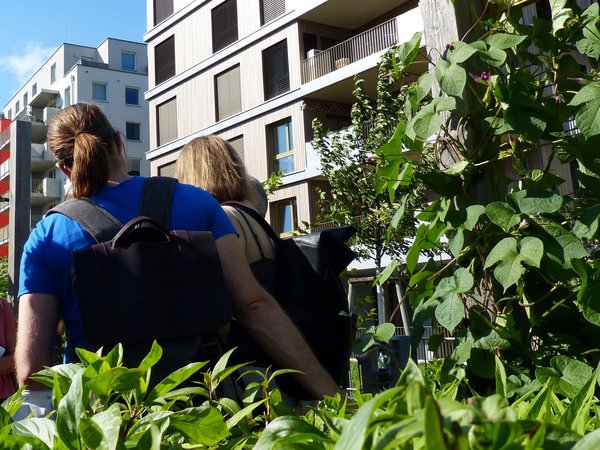
This tour through the Sonnwendviertel guided by the Gebietsbetreuung Stadterneuerung (GB*) is visiting three examples of communal housing and working in the neighborhood.
The city that is always growing: Guided tour of the Sonnwendviertel and Kreta neighborhoods

On this tour we are crossing two neighborhoods of Favoriten: the new Sonnwendviertel Ost and the historic Kreta neighborhood.
The city that is always growing: Guided tour of the Sonnwendviertel and Kreta neighborhoods

On this tour we are crossing two neighborhoods of Favoriten: the new Sonnwendviertel Ost and the historic Kreta neighborhood.
The city that is always growing: Guided tour of the Sonnwendviertel and Kreta neighborhoods

On this tour we are crossing two neighborhoods of Favoriten: the new Sonnwendviertel Ost and the historic Kreta neighborhood.
The city that is always growing: Guided tour of the Sonnwendviertel and Kreta neighborhoods

On this tour we are crossing two neighborhoods of Favoriten: the new Sonnwendviertel Ost and the historic Kreta neighborhood.
The city that is always growing: Guided tour of the Sonnwendviertel and Kreta neighborhoods

On this tour we are crossing two neighborhoods of Favoriten: the new Sonnwendviertel Ost and the historic Kreta neighborhood.
The city that is always growing: Guided tour of the Sonnwendviertel and Kreta neighborhoods

On this tour we are crossing two neighborhoods of Favoriten: the new Sonnwendviertel Ost and the historic Kreta neighborhood.
The city that is always growing: Guided tour of the Sonnwendviertel and Kreta neighborhoods

On this tour we are crossing two neighborhoods of Favoriten: the new Sonnwendviertel Ost and the historic Kreta neighborhood.
Round Table Sonnwendviertel Ost - Stakeholders: Tour & Discussion

As a discussion platform on the six topics of stakeholders, mixed use, public space, housing, mobility and architecture, this series of events invites you to wander through the new neighborhood at Helmut-Zilk-Park.
Round Table Sonnwendviertel East - Mixed use: Tour & Discussion

As a discussion platform on the six topics of stakeholders, mixed use, public space, housing, mobility and architecture, this series of events invites you to wander through the new neighborhood at Helmut-Zilk-Park.
Round Table Sonnwendviertel Ost - Public Space & Open Space: Tour & Discussion

As a discussion platform on the six topics of stakeholders, mixed use, public space, housing, mobility and architecture, this series of events invites you to wander through the new neighborhood at Helmut-Zilk-Park.
Round Table Sonnwendviertel Ost - Housing: Tour & Discussion
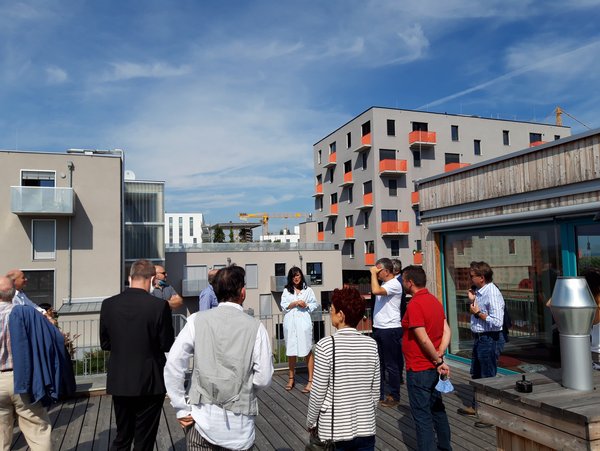
As a discussion platform on the six topics of stakeholders, mixed use, public space, housing, mobility and architecture, this series of events invites you to wander through the new neighborhood at Helmut-Zilk-Park.
Round Table Sonnwendviertel Ost - Mobility: Tour & Discussion

As a discussion platform on the six topics of stakeholders, mixed use, public space, housing, mobility and architecture, this series of events invites you to wander through the new neighborhood at Helmut-Zilk-Park.
Round Table Sonnwendviertel Ost - Architecture: Tour & Discussion

As a discussion platform on the six topics of stakeholders, mixed use, public space, housing, mobility and architecture, this series of events invites you to wander through the new neighborhood at Helmut-Zilk-Park.
"Mein letztes Auto": Performance

„Mein letztes Auto“ ist eine interaktive Performance, die sich vor dem Hintergrund des Klimawandels mit der Liebe zum Auto beschäftigt.
Quartiershäuser Sonnwendviertel: Führung mit Robert Temel*

Robert Temel, Architektur- und Stadtforscher, führt durch das Sonnwendviertel Ost, gibt Einblick in die aktuellen Entwicklungen im jüngsten Stadtteil rund um den Wiener Hauptbahnhof und erläutert den Typus des „Quartiershauses“.
Freiraum im neuen sozialen Wohnbau: Diskussion*

Die IBA_Wien Wohnbaufreiräume zeigen neue Ansätze, wie sozialen und ökologischen Herausforderungen auf innovative Weise begegnet werden kann. Eine Kooperation mit ÖGLA / Haus der Landschaft.
Quartiershäuser Sonnwendviertel: Filmvorführung "Bahnbrechend anders wohnen – Gleis 21"*

Eine Gruppe von Menschen will miteinander Wohnraum schaffen und diesen gemeinsam gestalten: Dies ist der Ausgangspunkt des Dokumentarfilms der österreichischen Regisseurin Andrea Eder. Die ORF-Koproduktion zeigt die Entstehung des Wohnprojekts Gleis 21 in einem neuen Stadtviertel nahe dem Wiener Hauptbahnhof.
Quartiershäuser Sonnwendviertel: Führung mit Robert Temel*

Robert Temel, Architektur- und Stadtforscher, führt durch das Sonnwendviertel Ost, gibt Einblick in die aktuellen Entwicklungen im jüngsten Stadtteil rund um den Wiener Hauptbahnhof und erläutert den Typus des „Quartiershauses“.
"Mein letztes Auto": Performance

„Mein letztes Auto“ ist eine interaktive Performance, die sich vor dem Hintergrund des Klimawandels mit der Liebe zum Auto beschäftigt.
Sonnwendviertel – "Das Wohnhaus als Begegnungszone": Praxis-Check*
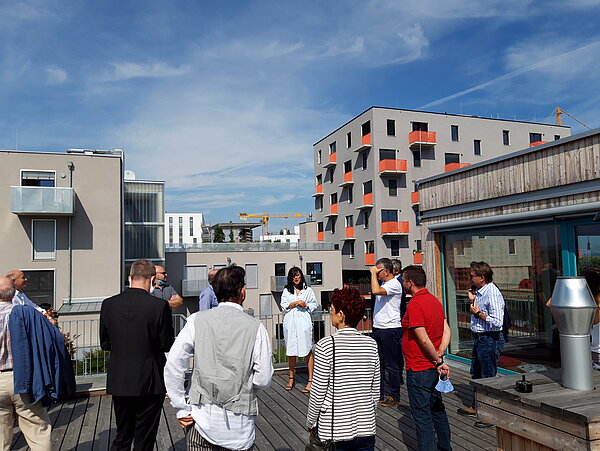
WohnenPlus und die Wohnen Plus Akademie laden zum Praxis-Check ins Sonnwendviertel Ost unter dem Titel „Das Wohnhaus als Begegnungszone“.
IBA-Talk: Schafft Wohnbau Quartiere?

Perspektiven zur qualitätsvollen Quartiersentwicklung
IBA-Talk: Wohnbau und Mobilität

Wohnbau und Mobilität - Von der Tiefgarage zum „Mobility Point“?
IBA-Talk: Gemischte Stadt

Spielräume und Modelle für eine urbane Nutzungsmischung
IBA-Talk: Freiraum unter Druck

Freiraum unter Druck - Nutzungsansprüche und Gestaltungsoptionen
Cooperation Partners
Lienfeldergasse 96
1170 wien



